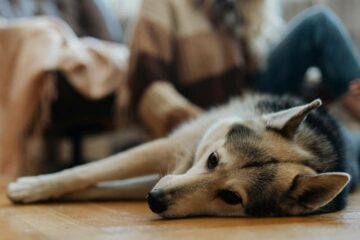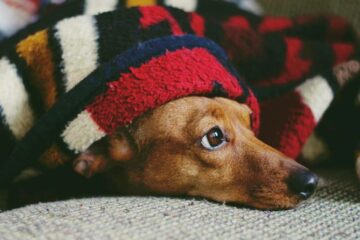Dog Ate Tissues? Why Does My Dog Eat Tissues?
“Why does my dog eat tissues?” In this article, we’ll cover all you need to know about your dog eating tissues, including what to do if your dog ate tissues just recently. We’ll then teach you the two commands that will ensure your dog stays away from your used Kleenex from now on.
Next, we’ll explain to you why dogs eat tissues (and what it means when your dog eats snotty tissues), plus how long they’ll take to pass. Finally, we’ll instruct you on if your dog eating tissues is safe and of course, how to stop your dog eating Kleenex once and for all. Keep reading!
My Dog Ate a Tissue, What Should I Do?

If your dog ate a tissue, don’t panic. Most dogs will pass small amounts of tissue without issue, but it’s important to monitor them for any signs of distress. Observe their behavior and check their stool for the tissue. If your dog ate tissues in large amounts or shows symptoms like vomiting, lack of appetite, or lethargy, contact your veterinarian.
What to Do if Your Dog Eats Tissues
If your dog eats tissues, follow these steps:
- Remain calm: Avoid overreacting as it can stress the dog.
- Assess the amount: A small amount of tissue may pass without incident, but larger quantities could cause an obstruction.
- Monitor your dog: Watch for any signs of gastrointestinal discomfort or distress.
- Check their stool: Look for the tissue in their stool within the next 24 to 48 hours.
- Contact the vet: If there are any concerning symptoms or if the tissue doesn’t appear in the stool, call your vet.
Dog Ate Tissue with Snot
If your dog ate a snotty tissue, then there are additional concerns:
- Used tissues could contain viruses and bacteria, especially if they were used by someone who is sick.
- Monitor for symptoms of illness such as diarrhea, vomiting, or unusual lethargy.
- If your dog shows signs of sickness, consult with your veterinarian right away.
Train the “Leave It” Command
Training your dog to respond to the “leave it” command can help prevent them from eating tissues:
- Begin with a treat in your hand: Show it to your dog, then close your fist.
- Wait for your dog to ignore the treat: Once they stop sniffing and licking, say “leave it” and give them a different treat as a reward.
- Practice with different items: Gradually increase the difficulty by using more enticing items, like a tissue, always rewarding your dog for obeying the “leave it” command.
- Ensure consistency: Regular practice in a variety of situations will solidify the command.
- Apply the command in real situations: Use the “leave it” command when they approach a tissue, rewarding them for compliance.
Train the “Drop It” Command
The “drop it” command is crucial if your dog picks up something they shouldn’t, like a tissue:
- Start with a toy: Engage your dog in play with a toy they like.
- Offer a treat: Once they have the toy, offer a treat and say “drop it.”
- Reward the release: When they release the toy, give them the treat and praise.
- Increase the challenge: Gradually work up to items they’re more inclined to hold onto, like a tissue.
- Practice consistently: Regular practice reinforces the behavior, making it more likely they’ll respond in a real-world scenario.
In summary, if your dog eats a tissue, monitor them closely for any negative reactions. If the tissue contains bodily fluids like snot, be even more vigilant due to the risk of illness.
Training your dog with commands such as “leave it” and “drop it” will help keep them safe, but it’s important to remember that the underlying behavioral issues (curiosity, anxiety, boredom, etc.) that were causing all of this to begin with will still be present. And until you address those, any positive changes you see will only be temporary.
“Well, how do I make these changes last?”
By getting your dog to truly choose to follow your direction, that’s how. I tried many times to write out how you can do that before deciding it made more sense to just link you to the free video series that explains it better than I’d ever be able to.
The series is by a man named Dan who is one of the world’s leading dog obedience trainers. In it, he teaches you how to put an end to things like your dog eating tissues and all other misbehavior using his fast and easy-to-follow methods.
In the first video, Dan will reveal to you why the two most common methods of dog training only doom you to failure. You can watch the video now by clicking here. Follow the proven system he’ll show you in his series and you’ll never have to spend another second worrying about your dog eating Kleenex ever again!
Why Does My Dog Eat Tissues?

Your dog eats tissues due to curiosity, boredom, anxiety, or the lingering scent of food or other enticing smells on the tissue. Some dogs engage in pica, a behavior where they eat non-food items, which can be driven by nutritional deficiencies or behavioral issues. It’s important to monitor your dog for any health changes or distress if they consume tissues.
Why Do Dogs Eat Tissues?
Dogs eat tissues for various reasons:
- The texture or taste of tissues may be appealing to them.
- Tissues may carry scents that attract dogs, such as human pheromones or food residues.
- Boredom or anxiety can also lead to inappropriate chewing and consumption of objects like tissues.
- Some dogs may have a condition called pica, leading to the ingestion of inedible items.
Training your dog on commands like “leave it” and “drop it” will be incredibly helpful for these situations. You can learn both now by going back to the first section.
It’s best to get this problem handled right away because a failure to do so could lead to the issue spreading to other similar areas. You may then find your dog eating napkins, your dog eating paper towels, your dog eating toilet paper rolls, your dog eating cardboard, or even something even nastier like your dog chewing the toilet brush.
Why Does My Dog Eat My Snotty Tissues?
Your dog eats snotty tissues because:
- They are attracted to the human scent and salts found in nasal mucus.
- Behaviorally, dogs are scavengers by nature and may not differentiate between food and waste.
- If a dog is lacking certain nutrients or has an underlying health issue, they may be more inclined to eat snotty tissues.
Always be sure that your used tissues are disposed of in a closed trash can to prevent your dog from accessing them.
Dog Ate Kleenex: How Long to Pass?
If your dog ate Kleenex (or tissues), the time it takes to pass through a dog’s digestive system can vary:
- Typically, small amounts of paper can pass through a dog’s system within 24 to 48 hours.
- Keep an eye on your dog’s bowel movements to ensure the tissue passes.
- If the tissue does not appear within a couple of days, or if the dog shows signs of distress, consult a vet.
- Regular, consistent bowel movements are a good sign that the tissue is moving through the digestive tract.
In conclusion, dogs eat tissues out of curiosity, anxiety, boredom, sensory satisfaction, or due to behavioral issues like pica. A dog eating snotty tissues poses additional risks due to the potential pathogens present in human mucus.
A dog will pass tissues they’ve eaten within a day or two, but if there are any health concerns, a veterinary check-up is a good idea. Prevention is key; keep tissues out of reach and dispose of them properly to avoid any potential health issues.
Dog Eating Tissues: Is It Safe?

A dog eating tissues is not safe, though it normally will not prove to be harmful. Tissues can cause blockages in the digestive system, especially if consumed in large amounts or if the dog is small.
Snotty tissues may carry additional risks due to bacteria and viruses in human mucus, which could potentially harm your dog. Monitoring your dog’s behavior and ensuring tissues are out of reach can help prevent any health issues.
Dog Eats Tissues Out of the Trash
A dog eating tissues out of the trash is a common behavior. It is not only unhygienic but also poses several health risks. The ingestion of tissues, particularly in significant quantities or in smaller breeds, can lead to gastrointestinal blockages, requiring immediate veterinary attention.
Furthermore, tissues from the trash may be contaminated with household toxins or food remnants that are unsuitable for canine consumption, thus presenting an additional layer of danger. Teaching your dog the “drop it” command can be great here; learn it now in the first section.
How to Prevent Dogs Eating Kleenex
The best way to prevent dogs from eating Kleenex or other tissue products is to remove the opportunity. This can be achieved by using trash cans with secure lids or placing them in cabinets or areas your dog cannot access.
Training is also a critical component; teaching your dog the “leave it” command can be invaluable. You can learn it now in the first section. Educate all family members about the importance of keeping tissues out of reach and consider using bitter apple spray on the tissue box during the training phase to deter your dog from chewing them.
Are Snotty Tissues Toxic to Dogs?
While snotty tissues are not inherently toxic to dogs, they pose a unique health threat due to the human biological material they contain. The bacteria and viruses present in a person’s mucus can be foreign to a dog’s system and may cause illness.
Beyond the biological risk, a dog eating used tissues raises the danger of them getting lodged in their digestive tract, which would be a very serious concern. If your dog exhibits signs of distress, such as vomiting, lack of appetite, or lethargy after eating a snotty tissue, it is crucial to consult with a veterinarian.
In summary, while a dog eating tissues is not inherently toxic, it can lead to complications such as digestive blockages or the transmission of human pathogens. It’s important to keep tissues disposed of securely and to train your dog to steer clear of them. Regular monitoring and good household habits can greatly reduce the risk of your dog eating tissues.
I’m sure you’re ready to begin now that you have all of your questions about your dog eating tissues answered, so I’ll let you get started. Good luck, and thanks for reading our article “Dog Ate Tissues? Why Does My Dog Eat Tissues?”





